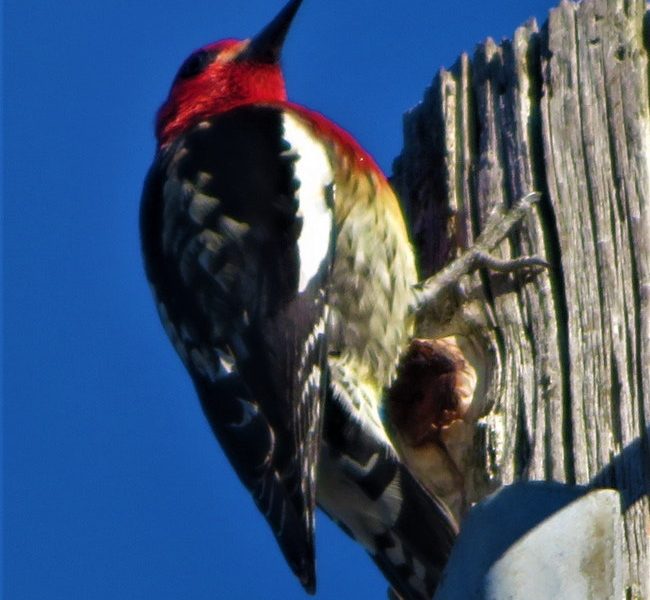
A sapsucker on top of pole, drumming, on Jan. 28, 2022 in Salem (Harry Fuller/Special to Salem Reporter)
The days are longer, nature is responding. Plants like crocus, violets and hellebore are blooming. Many bare trees are budding. Ducks are now in bright plumage and pairing up. And we shall be hearing that familiar drumming sound.
It will come from trees, utility poles, even chimney flashing or caps. The drummers will be woodpeckers.
Drumming is done by the male woodpeckers. No other family of birds can duplicate such behavior or sound.
Nearly all our woodpeckers here in Oregon use the same musical method. They begin hammering their beak against something hard and keep up a steady beat, sometimes slowing a bit as the sequence ends.
We have one species in the Willamette Valley that did jazz before that was a word. Nothing boring and steady for him. It is the red-breasted sapsucker whose drumming is syncopated – fast, pause, slow, fast – or some variable combo of unpredictable rhythms. When you hear such drumming look around for this medium-sized, brightly feathered bird. This species is also the one who makes all those small round holes in lines around the trunks of fruit trees and other soft barked trees. Those are its sap wells.
Among woodpeckers in the Willamette Valley are the small downy, the more robust hairy, the omnipresent flicker, and pileated in dense and mature forests. Pileated is the largest surviving woodpecker species in North America. Some mature groves of oaks have acorn woodpeckers who live in loud colonies.
 A pair of flickers at chimney, with a male facing away from the camera and female admiring (Harry Fuller/Special to Salem Reporter)
A pair of flickers at chimney, with a male facing away from the camera and female admiring (Harry Fuller/Special to Salem Reporter)
Drumming attracts a mate and announces territorial ownership. Sometimes the female will land near the drummer to admire and encourage. The louder the better. At the peak of drumming season, a mature male can carry on for half an hour or more. If you are inside the home while the flicker is at the chimney, you may need to escape.
Woodpeckers can be very good at finding hollow utility poles, loose flashing, a resonant dead tree trunk. Some drums are used by different species at different times. Volume matters. The bigger the bird, the louder. A pileated can make his drumming ring through the forest.
Woodpeckers make noise when chiseling a hole or getting food, but that is rarely a loud sequence. Drumming as a message stops when nesting begins. A spring ritual.
You and I could not pound our head or teeth against a solid piece of wood … without damage. So how? Well, woodpeckers and nature have evolved them to be impervious to slamming a hard beak against wood or metal. The placement of the brain, shape of the beak, spongy bones inside the skull—it is a complex set of adaptations that allow drumming without bird damage. There’s nothing hum-drum about woodpeckers.
The website produced by Cornell Orinthology Lab will let you hear the drumming and calls of any woodpecker in America: https://www.allaboutbirds.org/guide/
For information about upcoming Salem Audubon programs and activities, see www.salemsudubon.org, or Salem Audubon’s Facebook page.
Harry Fuller is an Oregon birder and natural history author of “Freeway Birding.” He is a member of the Salem Audubon Society. Contact him at [email protected] or http://www.towhee.net/. His “Some Fascinating Things About Birds” column will be appearing regularly in Salem Reporter.
JUST THE FACTS, FOR SALEM – We report on your community with care and depth, fairness and accuracy. Get local news that matters to you. Subscribe to Salem Reporter starting at $5 a month. Click I want to subscribe!









